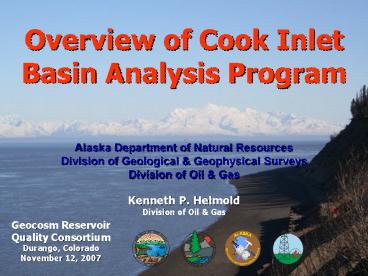Overview of Cook Inlet Basin Analysis Program PowerPoint PPT Presentation
1 / 26
Title: Overview of Cook Inlet Basin Analysis Program
1
Overview of Cook Inlet Basin Analysis Program
Alaska Department of Natural ResourcesDivision
of Geological Geophysical Surveys Division of
Oil Gas
Kenneth P. HelmoldDivision of Oil Gas
Geocosm ReservoirQuality Consortium Durango,
Colorado November 12, 2007
2
Collaborative effort between DGGS, DOG, UAF,
Purdue University and USGS
DGGS Dave Lepain, Marwan Wartes, Bob Gillis,
Paige Peapples DOG Diane Shellenbaum, Laura
Silliphant, Ken Helmold, Shaun Peterson UAF Paul
McCarthy, Jake Mongrain Purdue Ken Ridgway,
Emily Finzel USGS Rick Stanley
3
Location
4
Introduction
- Upper CI has thick Tertiary nonmarine strata
- Lower CI has thick Mesozoic marine strata
- Exploration has focused on structural traps in
Tertiary section - All oil and gas produced in CI comes from
structural traps in the Tertiary section - Oil is sourced from Middle Jurassic Tuxedni Fm
- Gas is sourced from Tertiary coals
- Stratigraphic traps in Tertiary strata represent
an under-explored play
5
- Collisional forearc basin filled with Mesozoic
and Cenozoic marine and nonmarine strata - Arc-trench system since latest Triassic
- Accretionary prism to E-SE
- Volcanic arc to W-NW
- Fault-bounded basin
Plafker and others, 1994
Pacific Plate
North American Plate
N.A. Plate
Pacific Plate
Fisher and Magoon, 1978
6
Stratigraphy
- Up to 30,000 feet of Mesozoic sedimentary rocks
- Up to 25,000 feet of Tertiary age Nonmarine
sedimentary rocks - Basin fill has been modified by folding and
faulting forming structural traps - Formations interfinger and are time transgressive
(shazzam lines) - Lithologies within formations interfinger
- Interfingering of lithologies is basis for
stratigraphic traps
From Curry and others (1993)and Swenson (2003)
7
Exploration Setting
- NNE-trending structures
- Faulted anticlines in Tertiary strata
- Faulting is syn- to post-depositional
- Structures formedrelatively late
- Involve olderMesozoic strata
Beikman (1980)
Modified from Hauessler and others (2000),
revised from Boss and others (1976)
8
Two Phase Approach
- Phase I Tertiary, Upper CI
- Potential for stratigraphic traps and
reservoir quality 2006 through 2009 Upper
Tertiary Homer Lower Tertiary Capps Glacier - Phase II Mesozoic, basin wide
- Reservoir potential of Mesozoic strata 2009
through 20??
9
Basin Analysis Goals
- Reconstruct depositional systems Tertiary and
Mesozoic strata - Evaluate potential for stratigraphic traps within
depositional systems context - Characterize known and potential source rocks
- Assess sealing capacity of reservoir seal facies
- Integrate results in a model of basin evolution
through time - Predict quality of potential reservoirs
10
Exploration History
- Exploration in early 1900s
- 9 oil exploration wells by 1940s
- Renewed interest in 1950s
- 16 oil exploration wells
- 2 discoveries
- Swanson River oil field 230 mmbls
- Kenai gas field 2.7 tcf
- Boom years 1960 to 1969
- 149 oil exploration wells
- 5 gas exploration wells
- 6 oil fields 1.1 bbls
- 12 gas fields 5.4 tcf
- Through 2006
- 262 oil exploration wells 73 gas
exploration wells - 9 oil fields 1.4 bbls
- 22 gas fields 8.9 tcf
Anchorage Museum Archives
Future Significant oil and gas potential remain
in the basin
11
Remaining Potential
- Little exploration effort specifically for gas -
DOE estimates 1.8 tcf remains undiscovered - Discovered recoverable oil volume estimated to
represent 4 of total generated (Magoon, 1994) - Exploration has focused on structural traps in
younger Tertiary nonmarine rocks - Mesozoic rocks are largely unexplored
- Basin is unexplored for stratigraphic traps
- As an indication of remaining potential many new
entrants are approaching DNR for information
12
Gas Supply versus Demand
(Thomas, 2006)
- Most gas in CI discovered as by-product of oil
exploration - Currently very little exploration for gas
- Gas deliverability shortfalls as early as 2008
13
Petroleum Systems
Modified from Magoon (1994)
- Tertiary Biogenic Gas
- Tuxedni (Jr) - Hemlock
- Kamishak (Tr) - Hemlock
- Mesozoic - Mesozoic
14
Depositional Systems
ARCO model (1980-90s) J. McGowen D.
Doherty serves as starting point
- Basin-margin alluvial fan - fan delta - braid
delta - Axial fluvial system
- Overbank suite Lacustrine Marsh Splays
15
West Foreland... possibly Hemlock?
Capps Glacier
16
West Foreland east of previous location.off
axis?
17
Petrologist at Work
Mt. Spurr
Capps Glacier
Projectile vomit from Mt. Spurr
18
Tyonek Fm.
30 meters
View toward east
Channel
Channel
19
Beluga Fm. View toward north
0
52 m
lower section - Lacustrine ?
Beluga River
channel scour
upper section - Fluvial Channels
20
Questions
- Do depositional systems in Tertiary strata occur
in predictable distributions within the forearc
basin? - Are there spatial and temporal variations in
sandstone composition across the basin, and how
do they affect diagenetic history? - How does depositional environment affect
sandstone reservoir quality? - How does reservoir quality within a given unit
vary across the basin as a function of burial? - Can reservoir quality of sandstones be predicted
prior to drilling - Does the generation of zeolites precede
hydrocarbon generation thereby condemning
prospectivity?
21
West Foreland Fm.
Theodore River
View toward west
View toward south
22
Is sand composition reflective of clast
composition?
23
The Rich Get Richer...
- Tertiary Sandstones Good guys
- Young age ( lt 65 million years old)
- Shallow burial (lt 10,000 feet)
- Chemically stable mineralogy (Quartz
K-feldspar) - Mesozoic Sandstones RQ-challenged
- Old age ( gt 65 million years old)
- Deep burial (gt 10,000 feet)
- Chemically unstable mineralogy (Plagioclase
VRFs)
24
Collecting friable sands
2. Transfer knowledge....
1. Innovate....
3. Monitor quality....
4. Manage
24
25
Sample preparation for friable sandsusing epoxy
2. Pouring.
1. Mixing.
3. Curing....
4. Transport
26
Helix field work
The End
Cool picture having absolutely nothing to do with
Cook Inlet

